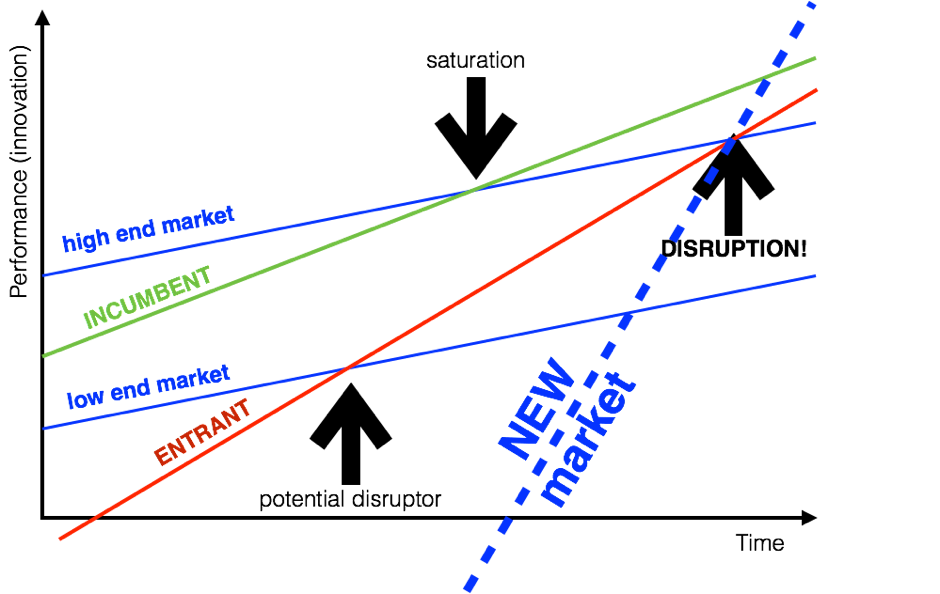Over 74% of CEO’s see their companies as disruptors… but what does disruption mean? In a recent KPMG survey 74% of CEO’s saw their companies as disruptors. Today the word disruption has become prevalent in the world of business hubris, with proponents and opponents alike. Many use the term liberally, yet few stop to think what it actually means, let alone understand what it really is. Given the extent and scale of the stated ambition of the leaders of many organisations it would seem important to do so. If you’re not sure and want a quick insight read on.
 Ian Huke Consultant, Build-BA, ian@build-ba.com
Ian Huke Consultant, Build-BA, ian@build-ba.com
Ian presented this topic at the Business Analysis Conference Europe 2017, in the session Disrupt & Thrive: Design Thinking & You alongside Paul Fletcher, Design Thinker & Photographer, Through. This article was previously published here.
Disruption Theory was developed by Clayton Christensen et al. in 1995. Interest in disruption has been growing largely fueled by the success of technology firms and the failure of some household names. Clayton himself has observed it has become a victim of its own success, being widely used to describe situations where it doesn’t apply.
So let’s start by looking at Clayton’s theory:
- Incumbent companies focus on improvements for their most demanding and profitable customers
- In doing this they exceed the expectations of some customers and ignore others
- New entrants target the overlooked segments, with a more suitable and often lower priced offering
- They then move upmarket meeting the needs of the incumbent’s core customers whilst retaining the benefits that drove the early success
- Disruption occurs when the incumbent starts losing customers in volume
A prime example of this is in short haul air travel. Here low cost entrants such as easyJet undermined the market of established airlines such as British Airways. Looking at the failure of the incumbent airlines to respond to these new entrants through setting up their own low cost carriers, such as Go, it would suggest its difficult if not impossible to disrupt your current market. Why? Because your legacy means you can’t gain the advantages of a new entrant.
Another important scenario is also highlighted. In this case:
- The new entrant creates a new market
- Customers of the incumbent find that their purpose is better served by the new market rather than the old (the new market may meet the purpose in a new way or make it redundant)
- The new entrants offering may not be low cost but is more meaningful to customers
- Disruption occurs when the incumbent starts losing its customers in volume to the new market
Looking at our airline example; we can see aircraft disrupting the passenger liner business in the 1960’s. The customers purpose is the same, to cross the Atlantic, however air travel was more meaningful due to the substantially shorter journey times. Now we could get ourselves all tied up in defining the market. The important point is what is understanding the market a company is serving. Although passenger liners offer transatlantic travel, their market is limited to those who want to travel by ship, not those wishing to fly. A new business model was needed to serve the purpose in a new way. It also worth noting that Disruption is not necessarily the end of the incumbent companies. Cunard still provides transatlantic liner voyages, in the form of cruising, but they serve a new leisure purpose.

Stepping away from the theory and into the real world it is the loss of customers in volume, that CEO’, shareholders and employees each experience. It is therefore helpful to look at disruption from this perspective.
Many of the stories we hear are of global disruption, often led from Silicon Valley. We forget that smaller organisations operating on a local scale who also face disruption, the loss of their customers in volume. Let’s take the simple case of the local department stores. Discount retailers coming to town were disruptive.
Returning to our CEO’s who want to be disruptors. To do this they will need either:
- To enter a new market as a low cost provider or
- Create a new market that serves customers in a more meaningful way
In either case fundamental organisational and business changes will be required.
Now this may not be the true intention of each of these CEO’s but what a great starting point for the conversation to understand their ambition.
What’s fantastic about these CEO’s is that they recognise the threat or disruption and have a desire to positivity respond to it. They want to exercise choice on their future and the future of their shareholders and employees. This is Positive Disruption.
To find out more about Positive Disruption and the role of Design Thinking, Thought Leadership and Strategic Innovation in making it happen: contact us at hello@through.org.uk. Find out more about us at www.through.org.uk
Ian started his professional life as a Litigation Lawyer, before quickly moving to work in technology and change. He now provides interim management and consulting services, focused on leading and developing organisation’s change capability. He is an advocate of business analysis and its key role in leading the design of valued experiences and valuable outcomes. His focus is developing people, culture and governance that can meet the demand for fast and flexible change. His experience covers a wide variety of organisations ranging from ftse100 companies to start up software houses, predominantly in the financial services sector.
Copyright Ian Huke, Consultant, Build-BA & Paul Fletcher, Design Thinker & Photographer, Through
References:
The ambition of CEO’s https://home.kpmg.com/content/dam/kpmg/uk/pdf/2017/06/2017-ceo-outlook.pdf
Clayton Christensen thoughts on disruption 20 years on: https://hbr.org/2015/12/what-is-disruptive-innovation
A 1967 view on the history of air travel http://www.bath.ac.uk/e-journals/jtep/pdf/Volume_1_No_2_164-183.pdf


